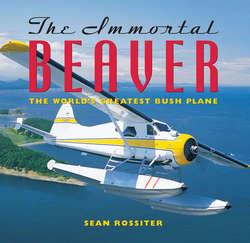Читать книгу The Immortal Beaver - Sean Rossiter - Страница 4
На сайте Литреса книга снята с продажи.
Acknowledgements
ОглавлениеThis project originated with the photographer Alex Waterhouse-Hayward, who caught me in a moment of weakness—leaving a downtown Vancouver bar, where he had been drinking soda water and I beer—and asked me to write a magazine article about the de Havilland Beaver. He wanted to photograph the aircraft and needed someone to write an article for him to illustrate. I said sure. This is one of the few promises made in bars that I have kept.
The article, headlined “The Beaver Then and Now,” appeared in the Georgia Straight. It explained the Beaver’s importance as today’s sole means of transport to many outposts along the British Columbia coast and was a finalist for a 1995 Western Magazine Award. Straight editor Charles Campbell deserves credit for buying an arcane idea, and the final result reflected careful editing and fact-checking by Martin Dunphy and Naomi Pauls. Scott McIntyre read that article and suggested this book.
In a coincidence that is unprecedented in my twenty-three years of freelance writing, Western Living magazine’s Sue Fisher asked me to write a Canadian Classics column on the Beaver at the same time. Editor-in-chief Paula Brook gracefully confirmed the assignment anyway, and that piece focused on the engineering decisions that resulted in the Beaver’s distinctive silhouette.
Aside from Dick Hiscocks, who has been available to me over more than two years for several formal interviews and numberless editorial chores, a number of survivors from the impressive de Havilland Canada team that conceived, designed and built the Beaver were generous with their time, memories and materials. First among these is Russ Bannock, the Beaver’s first test pilot and later president of the company during the difficult period of its ownership by the federal government. George Neal followed Bannock into the left-hand seat of CF-FHB, the prototype Beaver, certified it for float operation, and gave me an account of his occasionally-dangerous test flights. Neal is, like Bannock, a member of Canada’s Aviation Hall of Fame.
CF-FHB was registered in honour of Fred H. Buller, its chief design engineer and the man who more than any other was responsible for DHC’S successful postwar line of Short Takeoff and Landing (STOL) aircraft. His widow, Betty, and son, Christopher, offered personal insights into the wide-ranging mind and creative engineering approach of their husband and father. Chris, a heart surgeon, met Ernest Krahulec after performing a quadruple-bypass on his father’s wartime colleague, who filled me in on Fred’s pre-DHC contribution to the war effort and Krahulec’s own years working on FHB.
Others from the DHC team who offered unique perspectives were Bill Burlison, whose experimental shop constructed FHB, and Charlie Smith, who worked all night in the stores department in case the technicians who were readying FHB for its first flight needed any parts. John Garratt, son of then-DHC president Phil Garratt, who conceived the Beaver, provided valuable recollections of his father and the Beaver project. I relied heavily upon Fred Hotson’s accounts of the Beaver design process in The de Havilland Canada Story.
Steve Todd of Campbell River, British Columbia, a lifelong student of Beaver history, contributed many anecdotes from his extensive collection of Beaver lore. Among the West Coast pilots who told me their adventure stories covering fifty years of flying the Beaver were Tom Baxter, proprietor of Baxter Air of Nanaimo, B.C.; Lee Frankham of Campbell River; Larry Langford of Vancouver Island Air, Campbell River; Maurie Mercer of Finning Tractor, Vancouver; Bill Pennings, chief pilot of Harbour Air, Vancouver; Jack Schofield of Victoria, editor of West Coast Aviator and founder off Orca Air; and Gary Richards of Tofino Air Lines.
Special thanks to Ipaul Stenner, an Air Canada pilot who twice demonstrated his Beaver for me. Former flying-doctor pilot Joe Harvey of Perth, Australia, and the staff of the Royal New Zealand Air Force Museum at Wigram (especially Sgt. Cath Rowland) led me to accounts of the Beaver’s career Down Under.
Colin Fisher and Anita Paalanen of the de Havilland Regional Aircraft Division of Bombardier have been supportive from this project’s beginnings. And no writer about airplanes could have a better friend and mentor than Peter M. Bowers, who made his usual contribution to both the visual and written sides of this book.
Russ Bannock, Fred Hotson and Dick Hiscocks read the manuscript and eliminated countless mistakes. Robin Brass, who has edited many important works of Canadian aviation history, brought his unique insights and care to this project. Those errors of fact and judgement that remain despite the best efforts of these gentlemen are my responsibility alone. —SEAN ROSSITER
